Distributionally Robust Distributed Generation Hosting Capacity Assessment in Distribution Systems
Abstract
:1. Introduction
- We propose a DRO-based method to evaluate the HC of distribution networks considering uncertainties associated with loads and DGs’ output powers. As the statistic information (i.e., the first- and second-order moments) and the empirical distribution of uncertain variables are exploited in the assessment process, the results of the proposed method are practical and less conservative than those of the RO-based method. To the best of our knowledge, there is no such DRO application in power system that exploit both the statistic information and the empirical distribution simultaneously.
- In the proposed DRO-based method, a risk level is defined to control the robustness, enabling a trade-off between robustness and conservativeness. Unlike the robust optimization, tuning the risk level in the proposed method has a precise physical meaning, i.e., guaranteeing that the probability of operational constraints violation does not exceed a given risk threshold.
- The aggregated EVs and charging stations’ loads are modeled in the HC problem and their effects on the HC have been assessed. To the best of our knowledge, there is no such study that assesses the effect of aggregated EVs and charging stations’ loads on the HC of various types of DGs, i.e., PV, wind, and biomass.
2. Mathematical Modeling
2.1. Distribution System Model
2.2. Technical Constraints
2.2.1. Steady State Voltage Constraint
2.2.2. Thermal Capacity Constraints
2.2.3. Short Circuit Level (SCL) Constraint
2.3. Deterministic Problem Formulation Summary
2.4. Distributionally Robust Optimization (DRO) HC Model
3. Uncertainty Modeling
3.1. Uncertainty Modeling of PV Generation
3.2. Uncertainty Modeling of Wind Generation
3.3. Uncertainty Modeling of Biomass Generation
3.4. Uncertainty Modeling of Load
3.5. Uncertainty Modeling of EV Demand
3.5.1. Overall Charging Demand of EVs in a Local Residential Community
3.5.2. Overall Charging Demand of an EV Charging Station
3.6. Modeling the Confidence Set
4. Solution Methodology
4.1. Equivalent JCC
| Algorithm 1: Bisection line search algorithm for . |
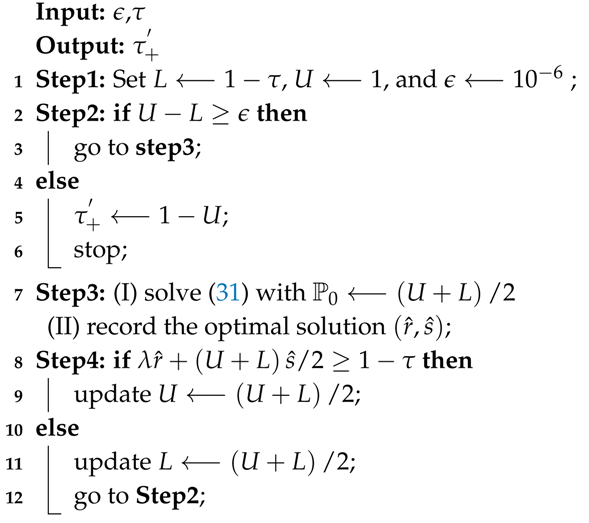 |
4.2. Sample Average Approximation (SAA)
5. Numerical Results
5.1. Test System
5.2. Simulation Results on the Modified IEEE 33-Bus System
- PV-HC: All DGs are PV systems.
- Wind-HC: All DGs are wind generators.
- Biomass-HC: All DGs are biomass generators.
- Combined-HC: The DGs at buses 15 and 32 are PV units, and the DGs at buses 22 and 25 are wind and biomass generators, respectively.
6. Conclusions
Author Contributions
Acknowledgments
Conflicts of Interest
Abbreviations
| DG | Distributed Generation |
| HC | Hosting Capacity |
| DRO | Distributionally Robust Optimization |
| JCC | Joint Chance Constrained |
| DSO | Distribution System Operator |
| EVs | Electric Vehicles |
| PV | Photovoltaic |
| RO | Robust Optimization |
| SO | Stochastic Optimization |
| PDFs | Probability Density Functions |
| SCL | Short Circuit Level |
| SOC | State of Charge |
| CDFs | Cumulative Density Functions |
| SAA | Sample Average Approximation |
| NHTS | National Household Travel Survey |
References
- Akbari, M.A.; Aghaei, J.; Barani, M.; Savaghebi, M.; Shafie-Khah, M.; Guerrero, J.M.; Catalão, J.P. New metrics for evaluating technical benefits and risks of DGs increasing penetration. IEEE Trans. Smart Grid 2017, 8, 2890–2902. [Google Scholar] [CrossRef]
- Wang, S.; Chen, S.; Ge, L.; Wu, L. Distributed generation hosting capacity evaluation for distribution systems considering the robust optimal operation of OLTC and SVC. IEEE Trans. Sustain. Energy 2016, 7, 1111–1123. [Google Scholar] [CrossRef]
- Vovos, P.N.; Harrison, G.P.; Wallace, A.R.; Bialek, J.W. Optimal power flow as a tool for fault level-constrained network capacity analysis. IEEE Trans. Power Syst. 2005, 20, 734–741. [Google Scholar] [CrossRef] [Green Version]
- Dent, C.J.; Ochoa, L.F.; Harrison, G.P. Network distributed generation capacity analysis using OPF with voltage step constraints. IEEE Trans. Power Syst. 2010, 25, 296–304. [Google Scholar] [CrossRef]
- Abad, M.S.S.; Verbič, G.; Chapman, A.; Ma, J. A linear method for determining the hosting capacity of radial distribution systems. In Proceedings of the Universities Power Engineering Conference (AUPEC), Melbourne, Australasian, 19–22 November 2017; pp. 1–6. [Google Scholar]
- Mahmud, M.A.; Hossain, M.J.; Pota, H.R. Voltage variation on distribution networks with distributed generation: Worst case scenario. IEEE Syst. J. 2014, 8, 1096–1103. [Google Scholar] [CrossRef]
- Koutroumpezis, G.N.; Safigianni, A.S. Optimum allocation of the maximum possible distributed generation penetration in a distribution network. Electr. Power Syst. Res. 2010, 80, 1421–1427. [Google Scholar] [CrossRef]
- Ochoa, L.F.; Padilha-Feltrin, A.; Harrison, G.P. Time-series-based maximization of distributed wind power generation integration. IEEE Trans. Energy Convers. 2008, 23, 968–974. [Google Scholar] [CrossRef]
- Ding, F.; Mather, B. On Distributed PV Hosting Capacity Estimation, Sensitivity Study, and Improvement. IEEE Trans. Sustain. Energy 2017, 8, 1010–1020. [Google Scholar] [CrossRef]
- Arshad, A.; Lindner, M.; Lehtonen, M. An Analysis of Photo-Voltaic Hosting Capacity in Finnish Low Voltage Distribution Networks. Energies 2017, 10, 1702. [Google Scholar] [CrossRef]
- Abad, M.S.S.; Ma, J.; Zhang, D.; Ahmadyar, A.S.; Marzooghi, H. Probabilistic Assessment of Hosting Capacity in Radial Distribution Systems. IEEE Trans. Sustain. Energy 2018. [Google Scholar] [CrossRef]
- Navarro-Espinosa, A.; Ochoa, L.F. Probabilistic impact assessment of low carbon technologies in LV distribution systems. IEEE Trans. Power Syst. 2016, 31, 2192–2203. [Google Scholar] [CrossRef]
- Chen, X.; Wu, W.; Zhang, B. Robust Capacity Assessment of Distributed Generation in Unbalanced Distribution Networks Incorporating ANM Techniques. IEEE Trans. Sustain. Energy 2018, 9, 651–663. [Google Scholar] [CrossRef] [Green Version]
- Santos, S.F.; Fitiwi, D.Z.; Shafie-Khah, M.; Bizuayehu, A.W.; Cabrita, C.M.; Catalão, J.P. New multistage and stochastic mathematical model for maximizing res hosting capacity—part I: problem formulation. IEEE Trans. Sustain. Energy 2017, 8, 304–319. [Google Scholar] [CrossRef]
- Chen, X.; Wu, W.; Zhang, B.; Lin, C. Data-driven dg capacity assessment method for active distribution networks. IEEE Trans. Power Syst. 2017, 32, 3946–3957. [Google Scholar] [CrossRef]
- Abad, M.S.S.; Ma, J.; Zhang, D.; Ahmadyar, A.S.; Marzooghi, H. Sensitivity of Hosting Capacity to Data Resolution and Uncertainty Modeling. In Proceedings of the 2018 Australasian Universities Power Engineering Conference (AUPEC), Auckland, New Zealand, 19–22 November 2017; pp. 1–6. [Google Scholar]
- Xiong, P.; Jirutitijaroen, P.; Singh, C. A distributionally robust optimization model for unit commitment considering uncertain wind power generation. IEEE Trans. Power Syst. 2017, 32, 39–49. [Google Scholar] [CrossRef]
- Wang, Z.; Bian, Q.; Xin, H.; Gan, D. A distributionally robust co-ordinated reserve scheduling model considering CVaR-based wind power reserve requirements. IEEE Trans. Sustain. Energy 2016, 7, 625–636. [Google Scholar] [CrossRef]
- Abad, M.S.S.; Ma, J.; Han, X. Distribution systems hosting capacity assessment: Relaxation and linearization. In Smart Power Distribution Systems, Control, Communication, and Optimization; Academic Press: Cambridge, MA, USA, 2018. [Google Scholar]
- Boutsika, T.N.; Papathanassiou, S.A. Short-circuit calculations in networks with distributed generation. Electr. Power Syst. Res. 2008, 78, 1181–1191. [Google Scholar] [CrossRef]
- Keane, A.; O’Malley, M. Optimal allocation of embedded generation on distribution networks. IEEE Trans. Power Syst. 2005, 20, 1640–1646. [Google Scholar] [CrossRef]
- Baran, M.E.; Hooshyar, H.; Shen, Z.; Huang, A. Accommodating high PV penetration on distribution feeders. IEEE Trans. Smart Grid 2012, 3, 1039–1046. [Google Scholar] [CrossRef]
- Xu, Y.; Dong, Z.Y.; Zhang, R.; Hill, D.J. Multi-timescale coordinated voltage/var control of high renewable-penetrated distribution systems. IEEE Trans. Power Syst. 2017, 32, 4398–4408. [Google Scholar] [CrossRef]
- Fabbri, A.; Roman, T.G.S.; Abbad, J.R.; Quezada, V.M. Assessment of the cost associated with wind generation prediction errors in a liberalized electricity market. IEEE Trans. Power Syst. 2005, 20, 1440–1446. [Google Scholar] [CrossRef]
- Atwa, Y.M.; El-Saadany, E.F.; Salama, M.M.A.; Seethapathy, R. Optimal renewable resources mix for distribution system energy loss minimization. IEEE Trans. Power Syst. 2010, 25, 360–370. [Google Scholar] [CrossRef]
- Wang, Z.; Wang, J.; Chen, B.; Begovic, M.M.; He, Y. MPC-based voltage/var optimization for distribution circuits with distributed generators and exponential load models. IEEE Trans. Smart Grid 2014, 5, 2412–2420. [Google Scholar] [CrossRef]
- Li, G.; Zhang, X.P. Modeling of plug-in hybrid electric vehicle charging demand in probabilistic power flow calculations. IEEE Trans. Smart Grid 2012, 3, 492–499. [Google Scholar] [CrossRef]
- Tehrani, N.H.; Wang, P. Probabilistic estimation of plug-in electric vehicles charging load profile. Electr. Power Syst. Res. 2015, 124, 133–143. [Google Scholar] [CrossRef]
- Alharbi, W.; Bhattacharya, K. Electric vehicle charging facility as a smart energy microhub. IEEE Trans. Sustain. Energy 2017, 8, 616–628. [Google Scholar] [CrossRef]
- Jiang, R.; Guan, Y. Data-driven chance constrained stochastic program. Math. Program. 2016, 158, 291–327. [Google Scholar] [CrossRef]
- Luedtke, J.; Ahmed, S. A sample approximation approach for optimization with probabilistic constraints. SIAM J. Optim. 2008, 19, 674–699. [Google Scholar] [CrossRef]
- Pagnoncelli, B.K.; Ahmed, S.; Shapiro, A. Sample average approximation method for chance constrained programming: theory and applications. J. Optim. Theory Appl. 2009, 142, 399–416. [Google Scholar] [CrossRef]
- Gharigh, M.K.; Abad, M.S.S.; Nokhbehzaeem, J.; Safdarian, A. Optimal sizing of distributed energy storage in distribution systems. In Proceedings of the Smart Grid Conference (SGC), Tehran, Iran, 22–23 December 2015; pp. 60–65. [Google Scholar]
- Tan, J.; Wang, L. Integration of plug-in hybrid electric vehicles into residential distribution grid based on two-layer intelligent optimization. IEEE Trans. Smart Grid 2014, 5, 1774–1784. [Google Scholar] [CrossRef]
- Darabi, Z.; Ferdowsi, M. Aggregated impact of plug-in hybrid electric vehicles on electricity demand profile. IEEE Trans. Sustain. Energy 2011, 2, 501–508. [Google Scholar] [CrossRef]
- Draxl, C.; Clifton, A.; Hodge, B.M.; McCaa, J. The wind integration national dataset (WIND) Toolkit. Appl. Energy 2015, 151, 355–366. [Google Scholar] [CrossRef]

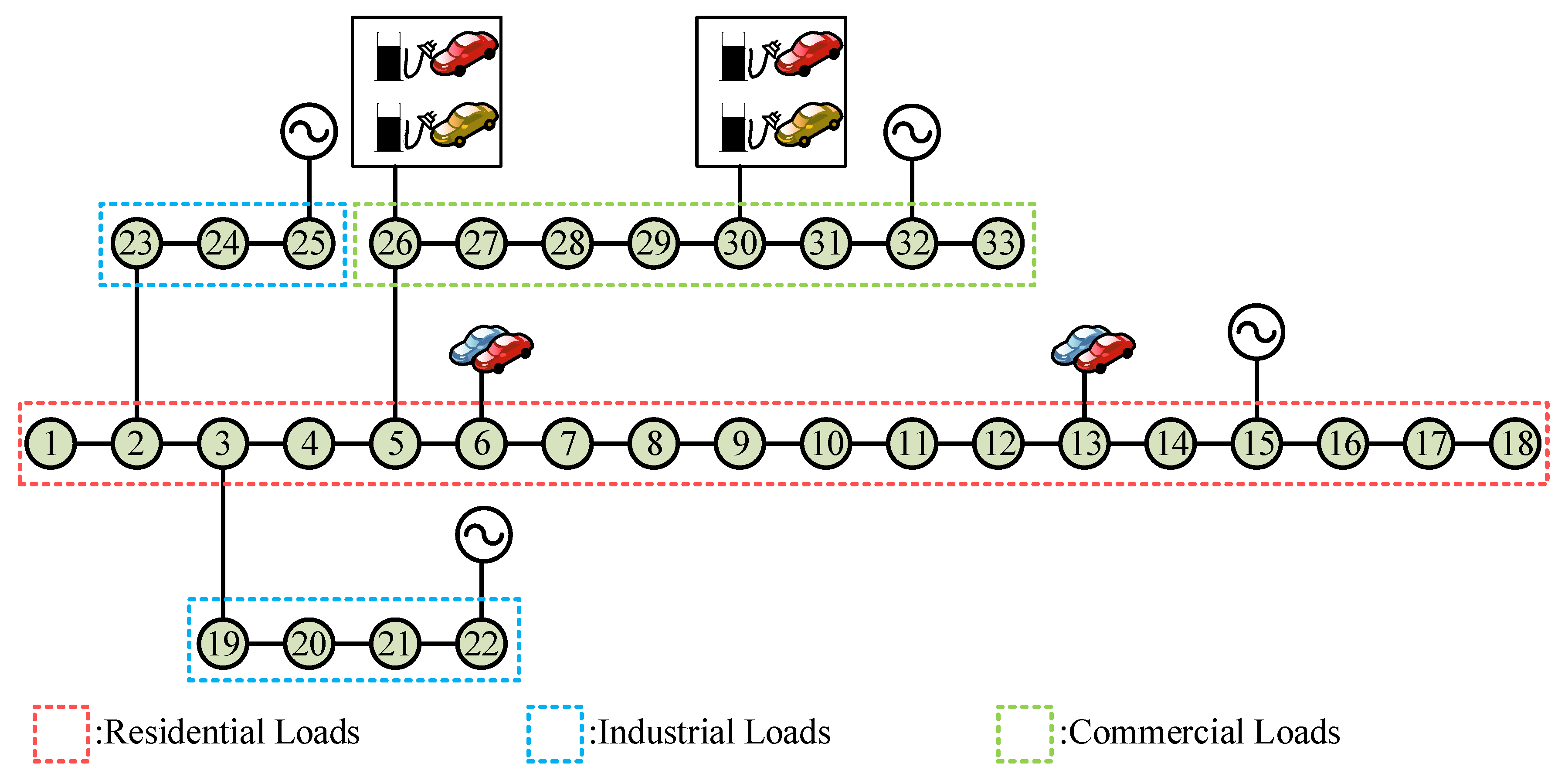
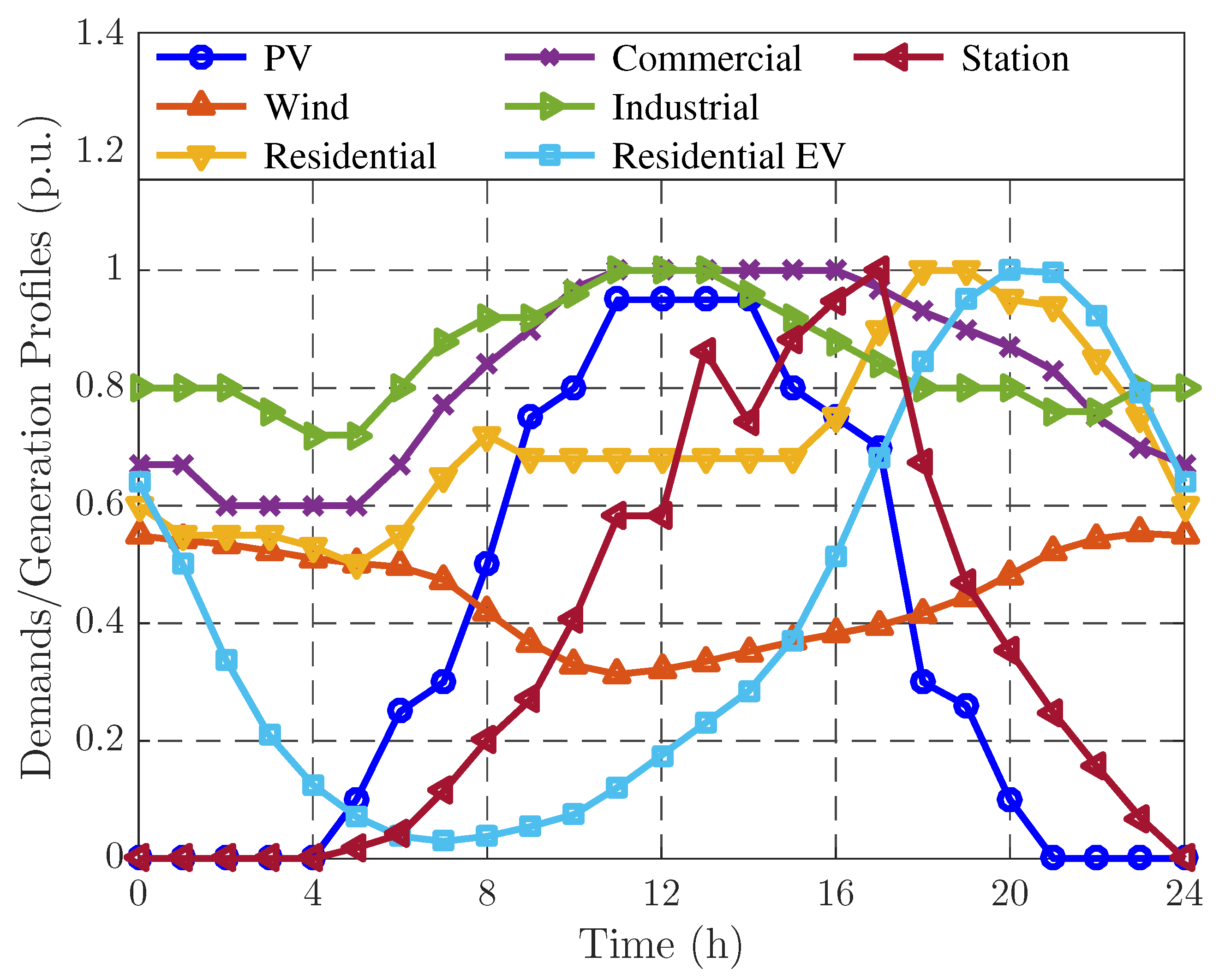
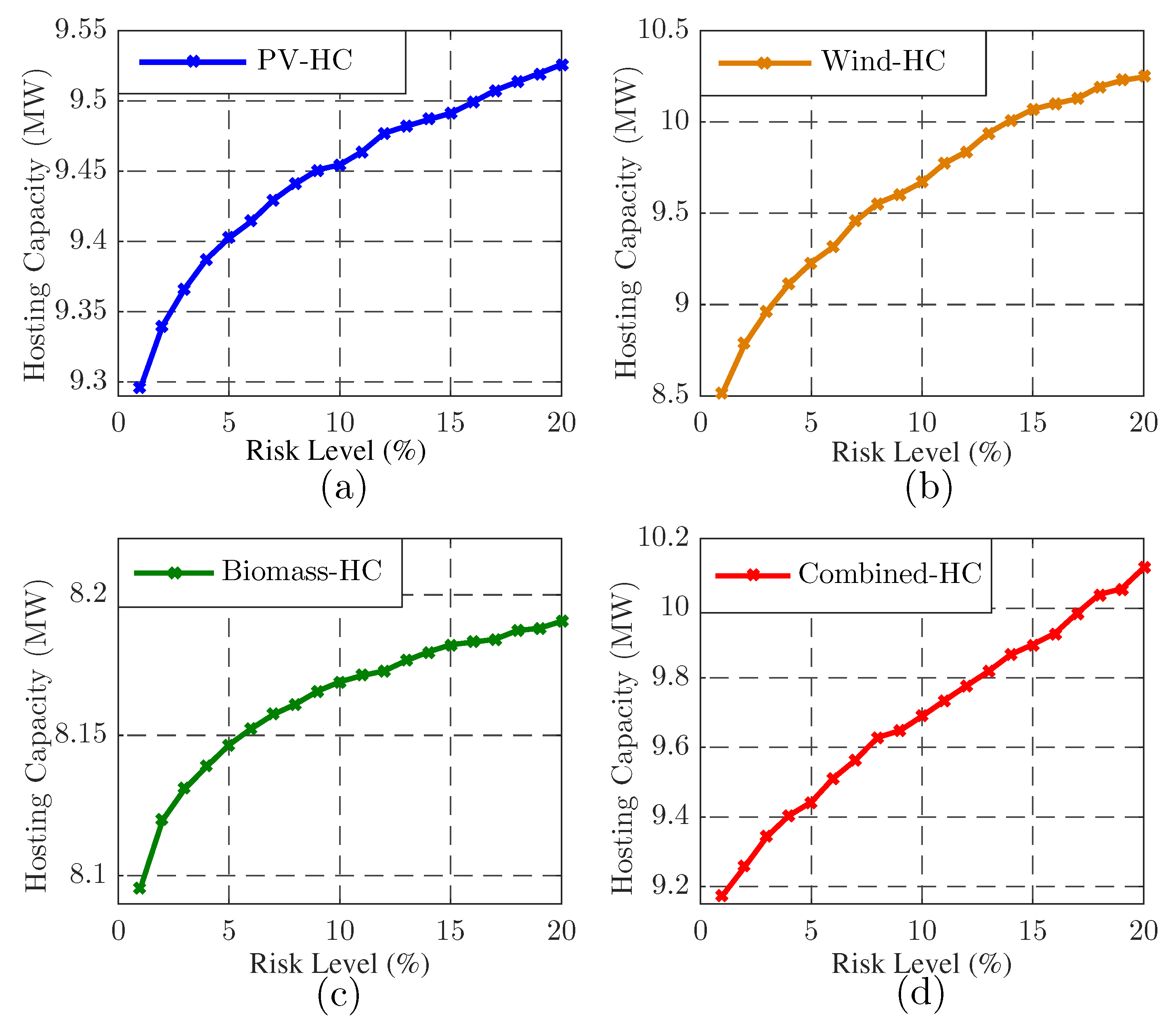
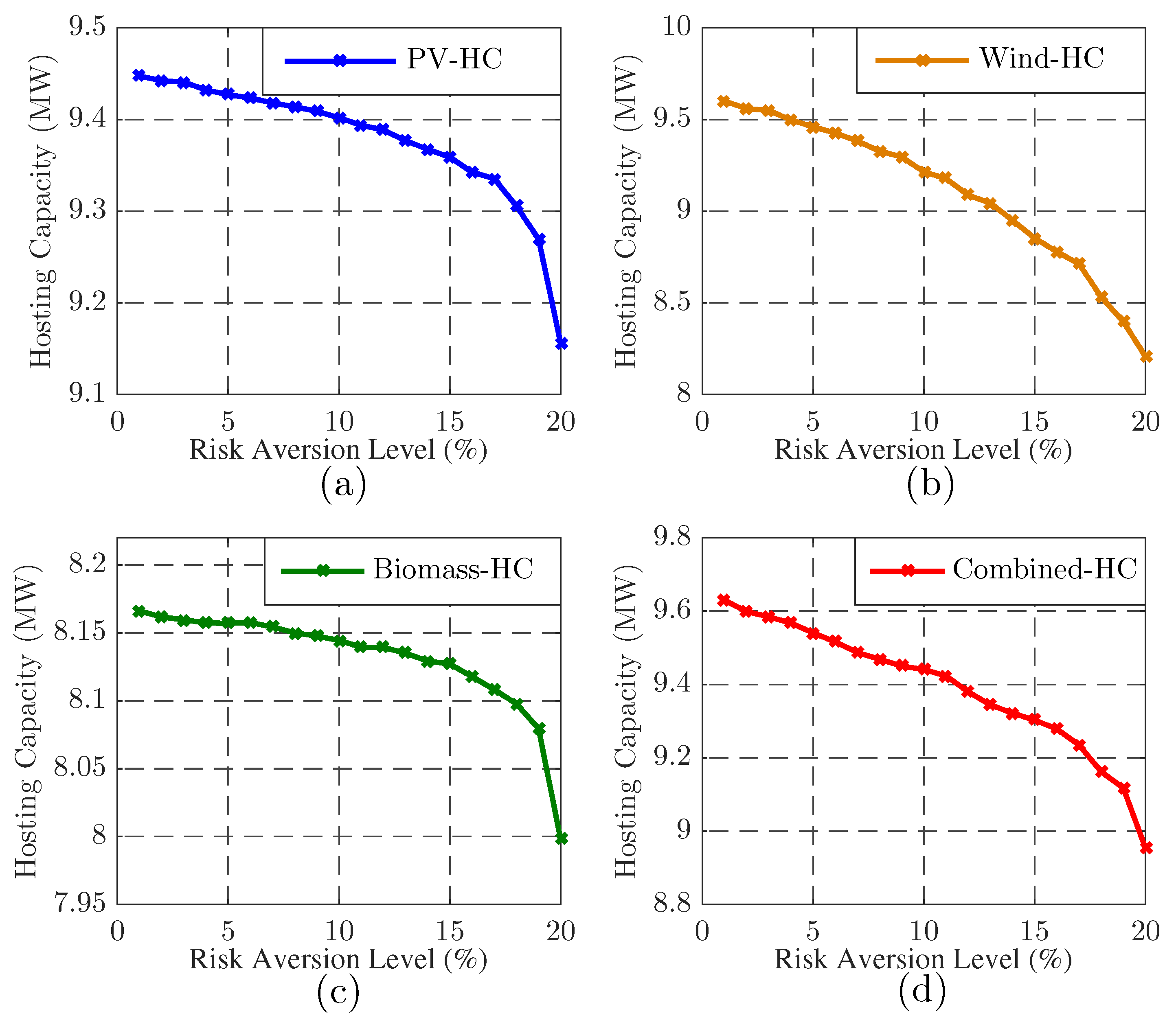

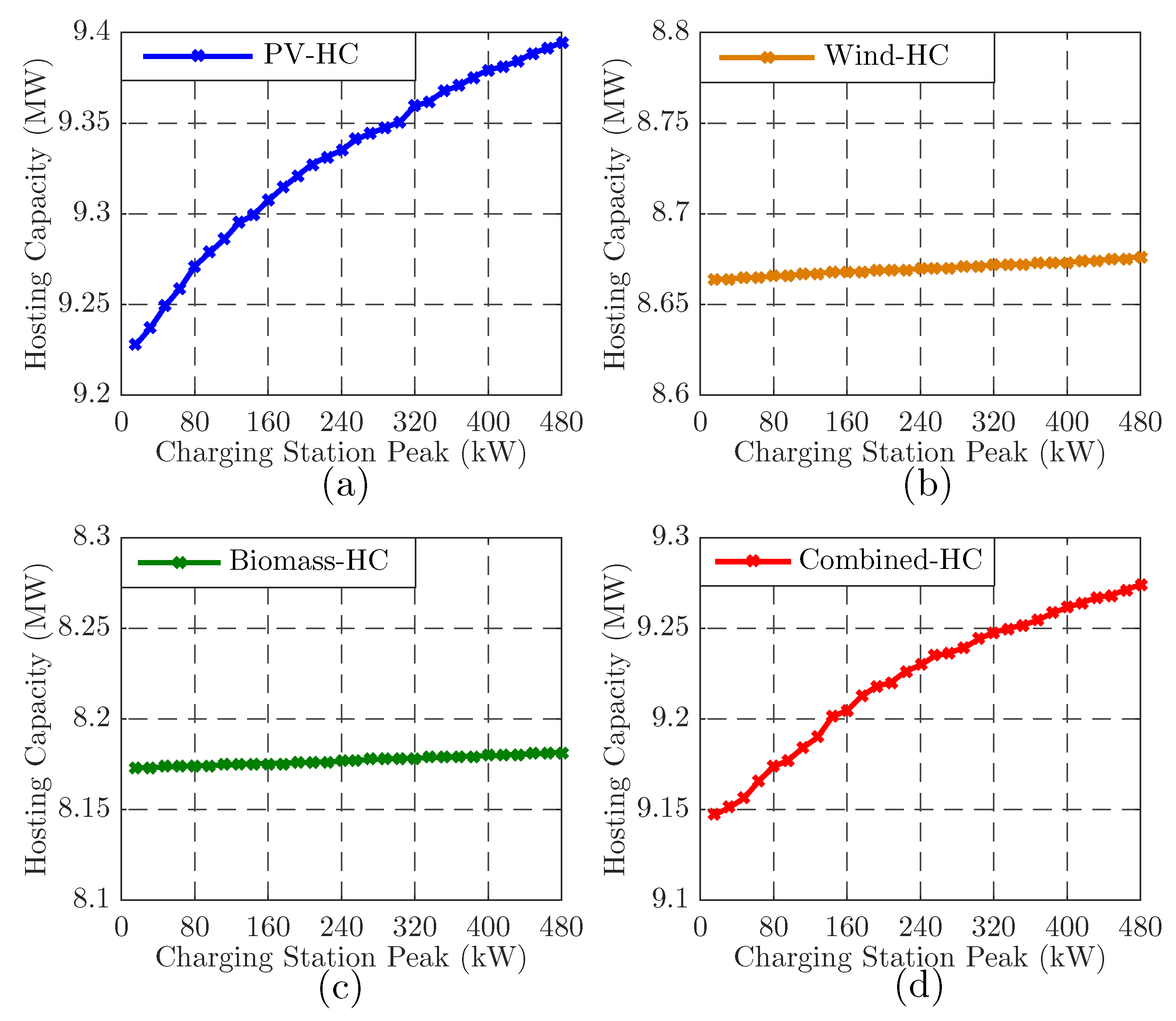
| Divergences | |||
|---|---|---|---|
| Variation distance | 1 | -1 | 1 |
© 2018 by the authors. Licensee MDPI, Basel, Switzerland. This article is an open access article distributed under the terms and conditions of the Creative Commons Attribution (CC BY) license (http://creativecommons.org/licenses/by/4.0/).
Share and Cite
Seydali Seyf Abad, M.; Ma, J.; Ahmadyar, A.S.; Marzooghi, H. Distributionally Robust Distributed Generation Hosting Capacity Assessment in Distribution Systems. Energies 2018, 11, 2981. https://doi.org/10.3390/en11112981
Seydali Seyf Abad M, Ma J, Ahmadyar AS, Marzooghi H. Distributionally Robust Distributed Generation Hosting Capacity Assessment in Distribution Systems. Energies. 2018; 11(11):2981. https://doi.org/10.3390/en11112981
Chicago/Turabian StyleSeydali Seyf Abad, Mohammad, Jin Ma, Ahmad Shabir Ahmadyar, and Hesamoddin Marzooghi. 2018. "Distributionally Robust Distributed Generation Hosting Capacity Assessment in Distribution Systems" Energies 11, no. 11: 2981. https://doi.org/10.3390/en11112981
APA StyleSeydali Seyf Abad, M., Ma, J., Ahmadyar, A. S., & Marzooghi, H. (2018). Distributionally Robust Distributed Generation Hosting Capacity Assessment in Distribution Systems. Energies, 11(11), 2981. https://doi.org/10.3390/en11112981





